Abstract
Retusa pertenuis is still formally considered a junior subjective synonym of Retusa obtusa, despite previous data indicating R. pertenuis and R. obtusa differ significantly in copulatory system morphology. In this paper, we study the species identity and population structure of R. pertenuis with an integrative approach combining morphological and molecular data. The external morphology, head copulatory system and gizzard plates were studied using light microscopy and scanning electron microscopy. We also obtained two mitochondrial (COI and 16S) and two nuclear (H3 and 28S) markers to test the monophyly of R. pertenuis and R. obtusa. Populations from the White Sea, Sea of Okhotsk and Sea of Japan were studied using COI and 18S molecular markers. Our results show that Retusa obtusa sensu lato represents a species complex of at least four species: the nominative species occurring in the North Atlantic, the widely distributed R. pertenuis and two additional species whose identities should be clarified in further studies. Retusa pertenuis geographic range encompasses the North Atlantic, Eurasia’s northern seas, the Canadian Arctic, the Bering Sea, the Sea of Okhotsk and the Sea of Japan. Within R. pertenuis’s range, this species demonstrates a wide variability in shell morphology.
1. Introduction
The heterobranch gastropod molluscs of the order Cephalaspidea often inhabit silty and sandy–silty communities, sometimes dominating among other gastropods not only in abundance but also in biomass [1,2,3,4]. Such cases are typical for large arctic cephalaspids, such as Cylichna alba sensu lato (family Cylichnidae), Cylichnoides occultus sensu lato (family: Eoscaphandridae) and Praephiline finmarchica (M. Sars, 1859) (family: Philinidae). Species of the genus Retusa T. Brown, 1827 (family: Retusidae) usually have shells 2–4 mm in height, and their impact on total benthic community biomass is insignificant [5]. Nevertheless, they have a particular role in trophic chains, preying on foraminifers, minuscule gastropods [6,7] or even priapulid worms or knobby anemones (www.eol.org). They are also a common food source for haddock [8] or other fishes (www.eol.org).
In the Arctic, a common member of the family Retusidae is Retusa pertenuis (Mighels, 1843) [1,2,4,5,9,10,11,12,13,14,15,16,17,18,19,20,21,22,23,24,25,26,27,28,29]. The species was described in Casco Bay, Maine, USA, by Mighels [8] and is found in Atlantic and Pacific boreal waters [30,31,32,33,34,35]. However, this name is formally considered a junior synonym of R. obtusa (Montague, 1803) [36]. This decision was based on the work of Lemche [37], who presented a revision of Northern Atlantic and Arctic cephalaspid molluscs. In this work, Lemche chose the contour of their shells as the basis for revising the species status of many North Atlantic and Arctic cephalaspidean taxa. When transitional shell forms between two species were identified, Lemche considered them synonyms. In the case of R. obtusa, specimens possessing a transitional shell contour between R. obtusa and R. pertenuis were found by him in Greenland, on the northern coast of Norway and in Denmark—therefore, he designated these species to be conspecific and R. pertenuis to be a junior synonym of R. obtusa. Because of the limited data on the internal morphology of Cephalaspidea at that time, such a position is understandable. However, it was later shown that synonymization of many previously described cephalaspid species is unjustified and that widespread boreal–arctic species, such as Diaphana minuta T. Brown, 1827 (family Diaphanidae), and Cylichnoides occultus (Mighels & C.B. Adams, 1842) sensu Lemche, 1948, are species complexes [38,39,40]. Moreover, the shell shape can only serve as the basis for a preliminary guide for the systematic position of the taxon (for example, Adeorbis antarcticus Thiele, 1912, in the subclass Caenogastropoda), and the subsequent study of the morphology of soft tissues can significantly change its preliminary classification (Tomthompsonia antarctica (Thiele, 1925) in the subclass Heterobranchia) [41].
Lemche [37] suggested that Retusa pertenuis is common in all Arctic seas but does not have a separate species status. Instead, it represents a smaller variety or form [42,43], which is replaced by another larger form—R. obtusa—in southern regions and in more favorable conditions. Further studies either supported the synonymy of R. pertenuis and R. obtusa [6,36,44,45,46,47,48] or considered R. obtusa and R. pertenuis to be separate species [1,3,4,5,22,23,26,27,28,29,32,33,34,49,50,51] because of the morphological differences in the head copulatory apparatus [24,25,52,53]. It should also be noted that forms morphologically close to Arctic R. pertenuis were also found in waters of the Sea of Japan [27,35,52]. However, the species identities of R. pertenuis and R. obtusa have never been tested using molecular phylogenetic data—moreover, Arctic and Pacific R. pertenuis show significant variability in shell characteristics, which may indicate the presence of cryptic diversity. Thus, the main goal of our work was to evaluate the taxonomic status of R. pertenuis across its wide geographic range, including Arctic and North Pacific waters. We aimed to test its species identity using integrative morphological and molecular analyses, recover its population structure, and consider the inter- or intraspecific nature of its morphological variability.
2. Material and Methods
2.1. Collection of Material
The specimens for the present study (Figure 1) were collected by (1) Chaban E. M. and Kashenko N. V. at a depth of 70 m in Peter the Great Bay of the Sea of Japan (2016) using a bottom grab of 0.1 m2, and the specimens were fixed in 96% ethanol and kept at the Zoological Institute of the Russian Academy of Sciences, St. Petersburg (ZIN)—2 specimens; (2) Chaban E. M. and Chernyshev A. V. at depths of 49–122 m in Northern Primorye of the Sea of Japan during the 64th cruise of the R/V Akademik Oparin (2021) using a beam trawl, and the specimens were fixed in 96% ethanol and kept at the ZIN—244 specimens; (3) the National Scientific Center of Marine Biology (NSCMB), Russian Academy of Sciences, Vladivostok, at depths of 105–118 m in the Sea of Okhotsk (East Sakhalin and northwest Sea of Okhotsk) during the 56th cruise of the R/V Akademik Oparin (2019), and the specimens were fixed in 96% ethanol and kept at the Museum of NSCMB—34 specimens; and (4) Ekimova I. A. (2020–2021) and Chaban E. M. (2022) at depths of 30–80 m in the Kandalaksha Bay of the White Sea aboard the R/V Professor Zenkevich using a beam trawl, and the specimens were fixed in 96% ethanol and kept at the ZIN—126 specimens.
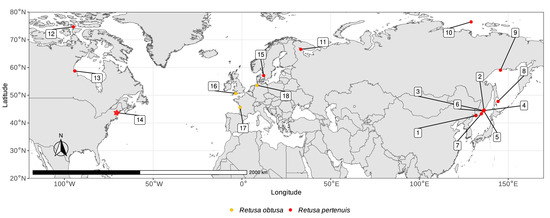
Figure 1.
Map of the R. pertenuis (1–15) and R. obtusa (16–18) sampling sites used for the molecular analysis and/or in Section 4 (Discussion). (1–7) Sea of Japan: (1) Peter the Great Bay, near Askold Is., and (2–7) North Primorye; (8–9) Sea of Okhotsk: (8) East Sakhalin and (9) northern Sea of Okhotsk; (10) Laptev Sea; (11) Kandalaksha Bay, White Sea; (12–13) Canada: (12) Churchill, Manitoba and (13) Resolute Bay, Nunavut; (14) Casco Bay, Maine, the type locality of R. pertenuis; (15) Halland, Sweden, glacial deposits; (16) Exeter, South England, where the syntypes of R. obtusa are kept (the type localities: Kent (?), Boys, Southampton, Salcombe, Laugharne) [54]; (17) Royan, Atlantic France; (18) North Sea, Germany; (data on the specimens from Arctic Canada (points 12 and 13) and Germany (point 18) were obtained from BOLD).
2.2. Morphological Methods
Shells were photographed using a digital DCM-130 camera with Scope Photo 3.0 software. Scanning electron microscopy (SEM; Quanta-250 FEI Company, Eindhoven, The Netherlands) was used to examine the shell and gizzard plates. The penial apparatus of the collected specimens was mounted in glycerol and examined under a Leica DME light microscope.
2.3. Molecular Methods
2.3.1. Taxon Sampling
Sixty-two specimens of Retusa pertenuis, collected in the White Sea, the Sea of Japan and the Sea of Okhotsk, were used for the molecular analysis (Table S1). We also used sequences of Retusa obtusa and R. pertenuis from the GenBank and BOLD databases (n = 8). All specimens were used to obtain the partial cytochrome c oxidase subunit I (COI) marker for the phylogenetic and population analyses. Fourteen specimens from different haplogroups were also used to obtain four additional markers (mitochondrial 16S rRNA and nuclear histone H3, 28S rRNA and 18S rRNA) to verify the species hypothesis and for the phylogenetic analysis. For the phylogenetic analysis, we also used all Retusa sequences from GenBank and BOLD (n = 24) for which at least the COI was available (Table S1). The Diaphana sp. was chosen as an outgroup.
2.3.2. DNA Extraction, Amplification and Sequencing
Total genomic DNA was extracted from tissue samples preserved in 96% ethanol (Table S1) following the invertebrate protocol of the Canadian Center for DNA Barcoding [55]. We performed an amplification of the partial mitochondrial cytochrome c oxidase subunit I and 16S rRNA and nuclear histone H3, 18S rRNA and 28S rRNA following the methods described in Chaban et al. [56,57]. Sequencing was performed with the NovaDye Terminator Cycle Sequencing Kit by GeneQuest (Moscow, Russia). Sequencing reactions were analyzed using an ABI 3500 Genetic Analyser (Applied Biosystems, Woburn, MA, USA) at the N.K. Koltsov Institute of Developmental Biology (Moscow, Russia). All novel sequences were submitted to the NCBI GenBank (Table S1).
2.3.3. Phylogenetic Analysis
All obtained sequences were assembled and checked for improper base-calling using Geneious R10 [58]. Original data and publicly available sequences were aligned with the MUSCLE [59] algorithm in MEGA 7 [60]. Indel-rich regions of the 16S alignment were identified and removed in Gblocks 0.91b [61] with the least stringent settings. Multigene analyses were conducted by applying evolutionary models separately to partitions representing single markers. The final lengths for each alignment were 604 bp for COI, 322 bp for 16S (after Gblocks), 324 bp for H3 and 333 bp for 28S. The best-fit nucleotide evolution models for the MrBayes phylogeny reconstruction method were selected in MEGA7 [60]. The best-fit models for each gene dataset were GTR + G + I for COI, HKY + G for 16S and K2P + G for H3 and 28S. Sequences were concatenated using a simple biopython script following Chaban et al. [62]. The Bayesian phylogenetic reconstruction was conducted in MrBayes 3.2 [63] for the concatenated multigene partitioned datasets. Markov chains were sampled at intervals of 500 generations. The analysis was initiated with a random starting tree and ran for 107 generations. The parameters of convergence were compared in TRACER v.1.5, where we also checked the model convergence (ESS > 200); 25% of trees were discarded as burn-in. The maximum likelihood phylogeny inference was performed in the HPC-PTHREADS-AVX option of RaxML HPC-PTHREADS 8.2.12 using the autoMRE algorithm for the determination of the number of replicates under the respective models of nucleotide evolution. The final phylogenetic tree image was rendered in FigTree 1.4.0 and further modified in Adobe Illustrator CS 2015.
2.3.4. Population Analysis
Original high-quality COI data and publicly available sequences (Table S1) were aligned with the MUSCLE [59] algorithm in MEGA 7 [60]. Haplotype networks were constructed using PopART 1.7 (http://popart.otago.ac.nz (accessed on 21 June 2023) [64] with the TCS network algorithm [65] and a connection limit of 5%. The resulting networks were edited in Adobe Illustrator CS 2015 to highlight certain features. To evaluate the divergence in nuclear markers, the 18S dataset was also examined as an indicator of the possible gene flow of distant Retusa pertenuis populations. For each population, the molecular diversity, haplotype diversity, and pairwise FST among populations (with 10,000 permutations of data) based on the COI alignment were calculated in DnaSP 5.10 [66].
3. Results
3.1. Molecular Analysis
The tree topologies from the Bayesian and the maximum likelihood analyses were congruent. Both trees (Figure 2) recover a high divergence of Retusa obtusa sensu lato (including R. pertenuis). This species forms a large clade (PP (posterior probabilities from BI) = 0.96, BS (bootstrap support from maximum likelihood) = 97), represented by specimens from the White Sea, the Sea of Okhotsk (EC391, EC392 and EC394) and the Sea of Japan, initially identified as R. pertenuis, as well as four specimens of Retusa obtusa from the Canadian Arctic (Manitoba and Nunavut). We initially identified this clade as R. pertenuis. This clade has a sister relationship with the North Pacific deep-water species R. operculata (PP = 1, BS = 87). A single specimen of R. obtusa from the North Sea (accession number: MH012218) forms a derived singleton, sister to R. operculata and the R. pertenuis clade, but these relationships do not receive high statistical support (PP = 0.75, BS = 24). Finally, one specimen from the Sea of Okhotsk (EC393) forms a derived singleton, as well as one specimen from the Canadian Arctic (ECHAR186_19). Within the clade of Retusa obtusa sensu lato and R. operculata, these two singletons branch away first (PP = 0.98, BS = 91). It should also be noted that other Retusa species from GenBank and BOLD also formed polyphyletic groups (for example, Retusa truncatula and R. umbilicata), but since the overall taxon sampling in Retusidae is low and these samples are from public databases, we do not specifically describe and discuss this result.
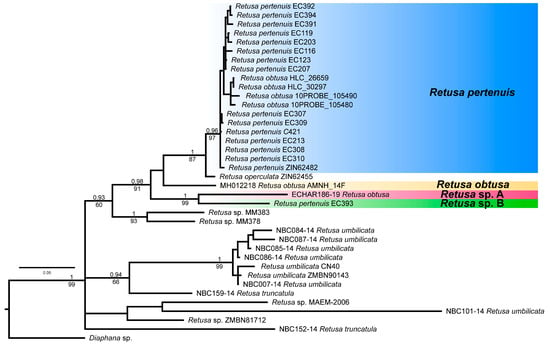
Figure 2.
Bayesian phylogenetic tree based on the concatenated dataset of four molecular markers (COI + 16S + H3 + 28S). Retusa obtusa sensu lato specimens are highlighted with colored boxes, where the different coloration corresponds to different putative species. The numbers above the branches indicate posterior probabilities from BI and numbers below the branches from bootstrap support from ML.
Uncorrected p-distances between different clades and singletons of R. obtusa sensu lato are given in Table 1.

Table 1.
Uncorrected interspecific p-distances in COI molecular marker for Retusa obtusa sensu lato species complex; the intraspecific p-distance for Retusa pertenuis is given in %.
3.2. Population Genetic Data
The COI-based TCS haplotype network of R. pertenuis (Figure 3) reveals a high geographical structure: all specimens from a single locality form separate groups, and there are no common haplotypes shared among representatives from different localities. The highest molecular diversity (Pi = 0.00734) is observed in specimens from the Canadian Arctic. Four specimens have three haplotypes differing by 7–8 substitutions, and these haplotypes form a separate cluster from the rest of the species diversity. The White Sea and Sea of Japan specimens form two separate compact groups with an ingroup diversity of Pi = 0.00175 (White Sea specimens) and Pi = 0.00112 (Sea of Japan specimens) (Table 2). In both cases, there is a single common haplotype shared among most specimens and several unique haplotypes differing from the common one by 1–5 substitutions. Three specimens from the Sea of Okhotsk are represented by three haplotypes (nucleotide diversity, Pi = 0.00893), form a group close to the White Sea haplogroup and differ from the common White Sea haplotype by 2–4 substitutions.
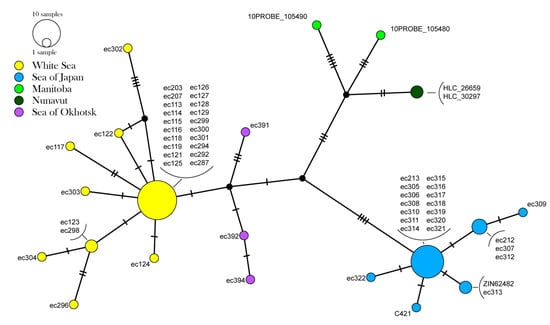
Figure 3.
COI-based haplotype network inferred with the TCS algorithm in PopArt. The colors of the circles refer to the geographic origin of each haplotype. The relative size of the circles is proportional to the number of sequences of that same haplotype.

Table 2.
Molecular diversity (Pi, diagonal line) within populations and pairwise FST values (lower-left) among populations in COI marker of R. pertenuis.
The global FST was high (0.70254)—the highest pairwise FST (0.86721) was observed between the White Sea and the Sea of Japan populations (Table 2). The pairwise FST values among the populations from Canada, the White Sea and the Sea of Japan were also high (0.65621–0.75161). The lowest FST (0.37828) was found between the White Sea and the Sea of Okhotsk populations.
The 18S dataset, based on specimens from different haplogroups, was used to test the geneflow restriction across distant populations. Although the 18S phylogenetic tree (Figure S1) shows several divergences within the White Sea population, populations from the Sea of Japan and the White Sea do not show monophyletic groups on the tree.
3.3. Morphology
3.3.1. External Morphology
Description of shell (Figure 4, Figure 5, Figure 6 and Figure 7): External, white, thick, oval or ovate–cylindrical, usually 2–3 mm in height, up to 4.0 mm, composed of 3.5 whorls, including a protoconch with a three-quarter whorl. The spire varies from nearly flat to relatively highly elevated. Teleoconch suture sallow, only slightly channeled. Protoconch drop-shaped, rarely protrudes beyond definitive whorls, ca. 190 × 260 µm in size, surface smooth. The periphery of the body whorl is oval. Maximum shell width at mid-height. The ratio of the shell width to its height varies from 56 to 73%. The aperture is pear-shaped, 76–100% of the body whorl height. The outer lip is almost straight or regularly oval, forming approximately a 50–53° angle with the parietal wall. Basal lip is round. The inner lip is more or less S-shaped, slightly calloused. The columella with a narrow reflection forms a narrow gap. Spiral sculpture of fine wavy grooves. Lines of growth are frequent.
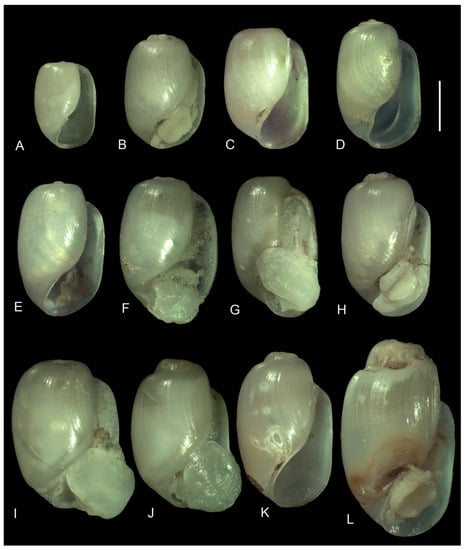
Figure 4.
Specimens of Retusa pertenuis from the White Sea used for the molecular phylogenetic analysis: (A) EC296; (B) EC113; (C) EC292; (D) EC294; (E) EC293; (F) EC129; (G) 304; (H) EC124; (I) EC114; (J) 302; (K) EC122; (L) EC203. Scale bar: 1 mm.
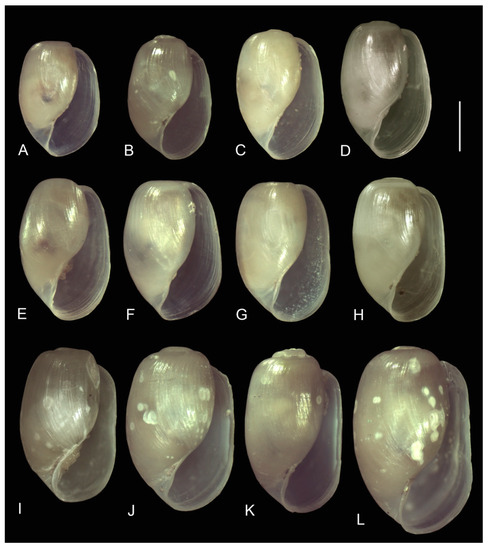
Figure 5.
Specimens of Retusa pertenuis from the Sea of Japan used for the molecular phylogenetic analysis: (A) EC314; (B) EC319; (C) EC309; (D) EC212; (E) EC306; (F) EC307; (G) EC311; (H) EC213; (I) EC322; (J) EC316; (K) EC318; (L) EC320. Scale bar: 1 mm.
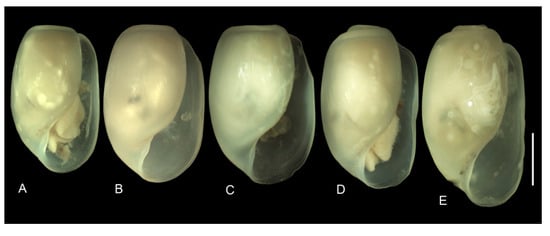
Figure 6.
Specimens of Retusa from the Sea of Okhotsk used for the molecular phylogenetic analysis: Retusa sp.—(A) EC393; Retusa pertenuis—(B) EC394; (C) EC390; (D) EC392; (E) EC391. Scale bar: 1 mm.
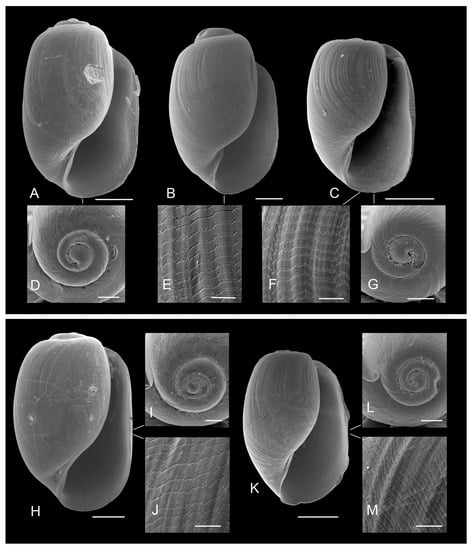
Figure 7.
Shell morphology of Retusa pertenuis (SEM) from Arctic (A–G) and Far East (H–M) Seas: (A,D) EC294 ((A) shell, ventral view and (D) apex); (B,E) EC302 ((B) shell, ventral view and (E) shell sculpture); (C,F,G) EC296 ((C) shell, ventral view, (F) shell sculpture, (G) apex); (H–J) EC316 ((H) shell, ventral view, (I) apex, (J) shell sculpture); (K–M) EC312 ((K) shell, ventral view, (L) apex, (M) shell sculpture). Scale bars: (A–C,H,K)—500 μm; (D,G,I,L)—200 μm; (E,F,J,M)—50 μm.
Remarks: The ratio of the shell’s width (w) to its height (h) in the White Sea specimens varied from 0.56 to 0.73, and many shells had an irregular shape. Individuals from the Sea of Japan had similar proportions, but the w/h ratio variability was lower (0.59–0.71) they are larger than the White Sea specimens (mostly 2.7–3.4 mm high, with a maximum registered size of 4.0 mm) and more regularly oval. Specimens from the Sea of Okhotsk were regularly oval. They were narrower (w/h = 0.56–0.66) and, generally, larger (h = 3.2–3.6 mm) than the specimens from the White Sea and Sea of Japan.
3.3.2. Internal Morphology
Gizzard Plate Morphology
Gizzard plates: (Figure 8 and Figure 9) ca. 0.3 mm in length, chitinous and oval, with numerous dark brown, blunt chitinous denticles growing through the plate. The unpaired plates were wider than the paired plates (Figure 9B,F,J). The chitinous layers formed a gizzard plate like a layer cake (Figure 9A,E,G). The narrow periphery zones of the plates were transparent and devoid of denticles. Large denticles formed a dense group on the lower end of the plates. The height of the teeth uniformly decreased from the lower to the upper end of the plates. The denticles were sometimes arranged in regular semicircles (Figure 8B,C and Figure 9A,C,F,I,K).
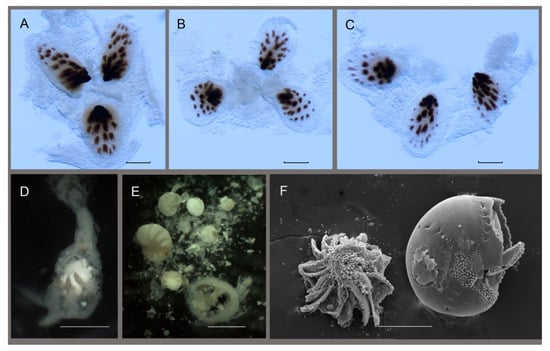
Figure 8.
Gizzard plates of Retusa pertenuis from the White Sea ((A) EC122) and the Sea of Japan ((B) EC212 and (C) EC213). Gizzard and foraminifera from specimens: (D) EC304; (E) EC121. Foraminifera from gizzard of specimen EC212 (F). Scale bars: (A–C,F)—100 μm; (D,E)—500 μm. ((A–E) light microscope photo; (F) SEM).
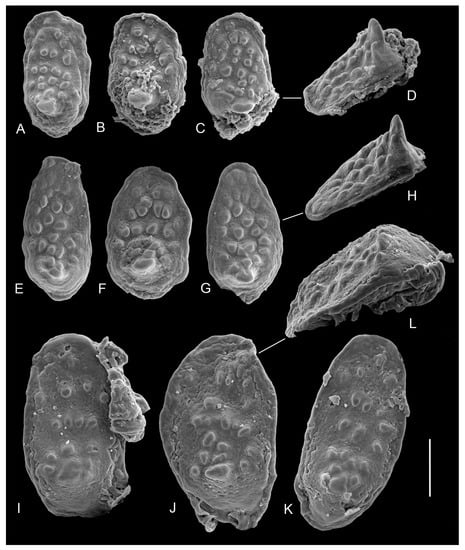
Figure 9.
Gizzard plates of Retusa pertenuis (SEM): (A–D) specimen EC119 (shell height: 2.7 mm) from the White Sea: (E–H) specimen EC302 (shell height: 2.9 mm) from the White Sea; (I–L) specimen EC320 (shell height: 4.0 mm) from the Sea of Japan ((A,C,E,G,I,K) paired plates, inner view; (B,F,J) unpaired plates, inner view; (D,H,L) lateral view). Scale bar: 100 μm.
Remarks: The gizzard plates of the specimens from the Sea of Japan were thicker than those of the specimens from the White Sea; their denticles were smaller (Figure 9L).
Copulatory Apparatus Morphology
The head copulatory apparatus (Figure 10) consists of incurrent seminal duct, penial sac, proximal prostate (pr), and bilobed distal appendages (spermatic bulb and ejaculatory duct—“sb–ed”). Muscle retractors are attached to the end of the prostate (m2) and to the base of the spermatic bulb–ejaculatory duct complex (m1). These retractors are sometimes hard to see. However, retractor m1 is usually thicker and more visible than retractor m2.
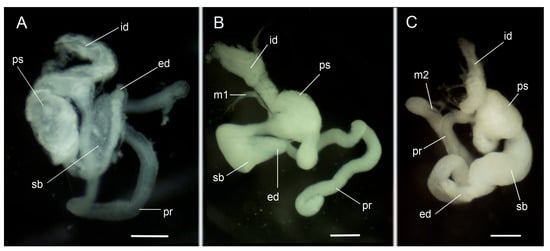
Figure 10.
Copulatory apparatus of Retusa pertenuis: (A) specimen EC304, from the White Sea; (B) specimen EC213, from the Sea of Japan; (C) specimen EC390, from the Sea of Okhotsk. Abbreviations: ed—ejaculatory duct; id—incurrent duct; m1—muscle of penial sac; m2—muscle of prostate; pr—prostate; ps—penial sac. Scale bars: 200 µm.
Remarks. The sb–ed gland complex enters the penial sac medially in individuals of the Sea of Japan (Figure 10B,C) and proximally in White Sea and Sea of Okhotsk specimens (Figure 10A,C and Figure 11F).
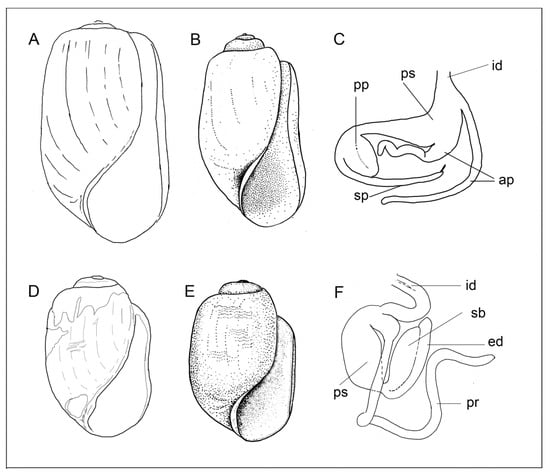
Figure 11.
Comparative shell and penial morphology of (A–C) Retusa obtusa and (D–F) R. pertenuis. (A,B) ZISP 23255, labeled as “Royan—Atlant. Francia”, collected and identified by T. A. Monterosato, shells, ventral view ((A) h = 6.0 mm and (B) 6.1 mm); (C) head copulatory system, scheme as in Berry et al. [67], including abbreviations; (D) ZISP 63563, shell, labeled as “Utriculus pertenuis (=syn. Bulla semen). Kvartar, glacial mergel, Varberg, Halland, #48. Fran Sveriges Geologiska Undersoknings Museum”, ventral view, h = 2.6 mm; (E) ZISP 23260, Laptev Sea, 08 October 1937, 76°46.5′ N, 129°08.5′ E, icebreaker Sadko, collected and identified by G. P. Gorbunov, specimen, ventral view, h = 2.6 mm, dissected; (F) head copulatory system, scheme of Figure 10A. Abbreviations: ap—accessory prostate; ed—ejaculatory duct; id—incurrent seminal duct; pp—penial prostate; pr—prostate; ps—penial sac; sp—sub-penial prostate.
All four appendages of the penial sac are inconsistently classified in the literature. Thompson [6] and Berry et al. [67] classify the proximal appendages as accessory prostates and distal ones as penial and subpenial prostates. In accordance with the study of histological sections, Minichev [68] considered the proximal appendage to simply be the prostate and called distal ones simply appendages. Similarly, Rudman [69], also having studied the histological sections on the example Relichna murdochi (Suter, 1913), referred to the proximal appendage as the prostate and to distal appendages as the spermatic bulb and ejaculatory duct. Considering that the presence of the seminal vesicle in the head copulatory apparatus was also noted by Ghiselin [70], we use the copulatory apparatus part names in accordance with the terminology proposed by Rudman [69].
3.4. Distribution
Retusa pertenuis is a widely distributed boreal–arctic circumpolar species found in Arctic seas from the Canadian Arctic to the Chukchi Sea. It was noted in the eastern North Sea from glacial deposits in Halland (Varberg). In the North Atlantic, it spreads south to western Norway and New England [22]. Several findings of this species are known from eastern Greenland [42], Iceland [19] and Svalbard [15,16,71]. The species was collected in the Barents Sea [4,10,21,22,28,29] and in the Kara Sea [3,5,20,50]. In the Laptev and East Siberian seas, it was collected and identified by G. Gorbunov and A. Golikov [2,24,52]. Retusa pertenuis is widely distributed in the White Sea [49] and was collected by us in the Kandalaksha Bay. In the northern Pacific, it is noted in the Bering Sea (from the Bering Strait to the Aleutian Islands) [16], the Sea of Okhotsk and the northwestern Sea of Japan [27,35,51,72] this study.
3.5. Ecology
Retusa pertenuis is an eurybiont species, usually inhabiting depths of 60–120 m, but its extreme bathymetric boundaries range from 3 m in the East Siberian Sea [26] to 1300 m in the Northern Atlantic (Lemche [37], as variety pertenuis). Specimens of this species were collected at a high salinity (31.30–34.86‰) in the Chukchi Sea, near the New Siberian Islands and in the central part of the Laptev Sea, as well as in areas of a high desalination (25.50–29.50‰) in the White Sea, in the Sannikov Strait and the Lena River Delta [24,52]. Retusa pertenuis is found both at relatively low temperatures (−1.67–+0.64 °C) and at relatively high temperatures (from +4.0 to +7.95 °C and even +15 °C) in the Arctic seas [25,49].
Retusa pertenuis has been recorded in a variety of benthic communities. In eastern Greenland, it is associated with the Macoma calcarea (Gmelin, 1791) community, but it can also be found in the Astarte borealis (Schumacher, 1817) + Pectinaria Lamarck, 1818 zone [42]. In Iceland, the species was found in the community of both Macoma calcarea and Yoldia hyperborea (A. Gould, 1841) [19]. Near the New Siberian Islands, R. pertenuis was the leading gastropod both in abundance (N = 40 ind./m2) and in biomass (B = 0.33 g/m2) at 2–5 m depths in the Cyrtodaria kurriana Dunker, 1861 biocenosis. R. pertenuis was less numerous at 10–18 m depths in the biocenosis Saduria sibirica (Burila, 1896) + Portlandia siliqua (A. Adams, 1856), at a 21 m depth in the biocenosis “Ludwigia” glacialis (Ljungman, 1879) and at a 31.5 m depth in the biocenosis Myriotrochus rinkii Steenstrup, 1851 + Saduria sibirica + Ophiura sarsi Lütken, 1855 [73].
Retusa pertenuis feeds on foraminifera (Figure 8D–F).
4. Discussion
4.1. Taxonomy
The descriptions and original drawings of Retusa obtusa and R. pertenuis (Montagu [74] and Mighels [8], respectively) show shells that are significantly different from each other. However, it may be challenging to distinguish them. For example, a photo of the R. obtusa shell from Zeeland, Netherlands, by J. Trausel and F. Slieker [36], and the syntype of Bulla pertenuis from the ANSP Malacology Collection, catalog no. 57340, have a similar outline. Nevertheless, Retusa obtusa and R. pertenuis have clear differences in copulatory system morphology and shell sculpture, indicating that they are two different species. The shell of R. obtusa is cylindrical, often widened in the lower third, with the lower edge of its outer lip bending to the right in most cases (Figure 11A,B). Such shells correspond to a description of the species by Montagu [74] and are similar to some syntypes of R. obtusa (see Oliver et al. [75]) from the Royal Albert Memorial Museum, Exeter [54]. In our opinion, the dilated aperture may be explained by their feeding on small gastropods [7]. The spire of R. obtusa can be either protruding or almost flat, the convex whorls are separated by a channeled suture (Figure 11A,B), and the spiral sculpture is missing [6]. Retusa pertenuis has a very thin but obvious spiral striation [10], which is clearly visible at high magnification (Figure 7E,F,J,M), especially on material from the Arctic seas. The study of materials from the collection of ZIN RAS, identified by S. Herzenstein, N. M. Knipowitch, G. P. Gorbunov and A. N. Golikov, confirmed the presence of a spiral striation in this species [10,52]. However, in wet specimens, especially those collected in boreal waters, the spiral sculpture is less rough and can be easily overlooked. The shell of R. pertenuis is oval or oval–cylindrical and shorter in specimens from Arctic seas (Figure 11E). The same shell, identified as Utriculus pertenuis, was found in glacial deposits in Halland, Sweden (Figure 11D). The copulatory apparatus of R. obtusa has four appendages: two thin, long and proximal, referred to in the literature as accessory prostates; two short and distal, referred to as penial and subpenial prostates [6,25,67] (Figure 11C). Retusa pertenuis has three appendages: proximal prostate, distal spermatic bulb and ejaculatory duct (Figure 10 and Figure 11F).
Summing up the morphological characteristics of the two species, we agree with Lemche’s definition, considering R. obtusa to be more adapted to warmer waters and not penetrating the Arctic. A comparison of the morphological characteristics and ecology of R. obtusa and R. pertenuis is shown in Table 3.

Table 3.
Comparison of R. obtusa and R. pertenuis.
Molecular analysis indicates that the species Retusa obtusa sensu lato is a complex of at least four species. Specimens from the White Sea, the Sea of Japan, the Sea of Okhotsk and from the Canadian Arctic form a separate clade that is sister to deep-water Retusa operculata (data from GenBank) and distinct from North Sea Retusa obtusa. Although specimens of R. obtusa from GenBank were not available for morphological analysis, the proximity of these specimens to the type locality R. obtusa in southern England suggests, nevertheless, that these specimens belong to R. obtusa sensu stricto. At the same time, our analysis did not include specimens from the type locality of R. pertenuis (Maine, USA), but the shell morphology of the specimens from the White Sea and the Pacific Northwest is similar to the species description [8,9,30] and syntype of Bulla pertenuis. The genetic conspecificity of the samples from distant localities across subarctic, Arctic and boreal waters supports the validity of Retusa pertenuis and the wide distribution of this species.
The species Bulla semen Reeve, 1885, was described from the Canadian Arctic (Port Refuge, Devon Is., and Nunavut), and it was later considered either a valid taxon [76,77,78] or a synonym of R. pertenuis [9,17]. The original description of the species is very short. The type material of this species has been lost. The image of B. semen [79] as a species with a short cylindrical shell differs significantly both from the oval and oval–cylindrical shells of R. pertenuis sensu of Mighels [8], Gould [30] and G. O. Sars [9] and from our material. Dall [78] noted Retusa semen from the Beaufort Sea (off Collinson point, west of the delta of the Mackenzie River) and off Port Clarence, Bering Strait, Alaska. Lemche [37] indicated R. semen as an “uncertain species”. According to his opinion, Dall “has simply regarded semen as a proper name for the common arctic species generally designated as pertenuis”. Retusa semen is currently considered a taxon inquirendum [5,36].
It should be noted that the type material of Retusa pertenuis was, for a long time, considered to be lost [18,27]. The identification of retusids of the northern Eurasian Seas was based on descriptions and illustrations for R. pertenuis by Mighels [8], Gould [30], G. O. Sars [9], as well as comparative material sent by colleagues (including those depicted in Figure 11A,B,D). This creates a situation in which there may be an imprecise view of what should be considered R. pertenuis. Despite the rediscovery of the Bulla pertenuis syntype [36], the study of its shell may be insufficient in light of the discovered cryptic diversity. This makes it of paramount importance to collect multiple samples of R. pertenuis from its type locality for a comprehensive integrative taxonomy study with the use of both morphological and molecular approaches for the final clarification of this subject. The primary goal of this work is limited to describing the diversity of what is considered the “common arctic species generally designated as pertenuis” [37] in northern Eurasian seas with updated information on its distribution.
Our data also indicate that the cryptic diversity within the Retusa obtusa species complex is even higher. Two specimens initially identified as R. obtusa and R. pertenuis from Canada and the Sea of Okhotsk (ECHAR186_19 and EC393, respectively) formed two derived singletons apart from the rest of the diversity (Figure 2). Unfortunately, the limited material does not allow us to study their external and internal morphology; therefore, this issue clearly needs further investigation.
4.2. Variability in the Morphological Characteristics across Distant Populations
Shell variability: Retusa pertenuis exhibits wide morphological variation across its vast range. In the 126 White Sea specimens that we studied, the shell height was predominantly 1.7–3.0 mm; rare specimens reached a size of 3.8 mm. The ratio of the shell width (w) to its height (h) varied widely (0.56–0.73); many of the shells were irregular in shape. The Sea of Japan population (244 specimens studied) was represented by larger mollusks, predominantly 2.7–3.4 mm in height, with a maximum of 4.0 mm. The ratio of the shell’s width to its height varied less (w/h = 0.59–0.71); they were more regularly oval in shape than the White Sea specimens. The Sea of Okhotsk’s R. pertenuis (34 specimens studied) were also generally larger than the Arctic forms: 2.8–3.6 mm high. They were of regular oval shape and narrower than the specimens from the White Sea and Sea of Japan (w/h = 0.56–0.66). There was also variation in the shell shape. The variability of this trait is especially important to study, since in the absence of a revision of the Retusidae family, it is precisely this trait that underlies the differential diagnoses of the species [16,37,45]. Both Arctic and Far Eastern R. pertenuis have an oval–cylindrical shape with a straight outer lip (Figure 4D,H,K, Figure 5H,I,K,L and Figure 6). In addition to an oval–cylindrical shape, there were also wide oval-shelled forms found in the Arctic (Figure 4F) and Far East (Figure 5A,B, Figure 6A,B and Figure 7K), though they were much more numerous in the Sea of Japan and Sea of Okhotsk populations. A peculiarity of the Far Eastern individuals was their shallow spiral grooves (Figure 7J,M) compared to the shells found in the Arctic. In general, the White Sea population was characterized by a great variability in the shell shape and large number of irregular forms (Figure 4L). Perhaps this is due to the White Sea’s low salinity.
Variability of the gizzard plates: Regarding the anatomical characteristics, the most striking differences were found in the gizzard plate morphology. The gizzard plates of the Sea of Japan individuals were much thicker than those of the White Sea individuals. In addition, their denticles were smaller than those on the plates of the White Sea specimens, especially the denticle of the distal (lower) pole, and were often arranged in regular semi-rings.
Variability of the head copulatory apparatus: There were slight differences in the morphology of the copulatory apparatus. In the Sea of Japan individuals, the spermatic bulb and ejaculatory duct complex flows medially into the penis sac, while in the White Sea and Sea of Okhotsk populations, it is distally connected.
4.3. Phylogeography
Overall, the COI-based haplotype network showed a high geographical structure and clear genetic separation of representatives from the White Sea, the Sea of Okhotsk, the Sea of Japan and the Canadian Arctic, suggesting restricted gene flow across distant localities. The global FST was high, and the highest pairwise FST (0.86721) was observed between populations from the White Sea and the Sea of Japan. Remarkably, specimens from the Sea of Okhotsk are genetically close to the White Sea specimens (pairwise FST = 0.37828), suggesting that the gene flow between these two distant localities might have occurred in the recent past. At the same time, the Sea of Japan population is distinct from that of the Sea of Okhotsk (FST = 0.72393), despite these areas having a hydrological connection and a shared biological and genetic diversity [80,81,82]. The genetic distinctness of geographically close and distant populations eliminates anthropogenic transportation as a primary driver for the wide species distribution. At the same time, this peculiar genetic pattern may be explained either by the dispersal abilities of R. pertenuis or its historic distribution pattern in the North Pacific and adjacent Arctic waters. Regarding the latter hypothesis, the genetic divergence observed in R. pertenuis may be recent, resulting from a reduction of the gene flow across the Arctic Ocean during several recent Pleistocene glacial cycles [83,84]. At the same time, direct development was shown for phylogenetically close R. obtusa, meaning this species does not have a free-living pelagic larval stage [85,86]. Although we do not know the exact developmental mode of R. pertenuis, the direct development of this species may be an explanation for the high geographical structure of its populations. A high geographic structure within species with direct development has already been hypothesized and shown before [87,88,89,90].
An obvious restriction of the gene flow across distant regions may indicate different populations of R. pertenuis represent young but distinct species. The identity of widely distributed species with amphiboreal, arcto-boreal or circumpolar distribution (so-called trans-Arctic distribution, see Laakkonen et al. [84]) is challenging, and the species criteria are still poorly defined [84,91,92,93]. Recent works on other heterobranch groups identified that most of these species represent species complexes [94,95,96]; however, for some species, their wide distribution range was confirmed [84,92,97]. In the latter case, species may demonstrate considerable morphological differences across distant populations which is, in fact, a part of a morphological variation continuum [92,97]. Corresponding studies have also suggested stable differences in nuclear markers as a primary phylogenetic criterium to support a separate species status of trans-Arctic populations [92]. In the case of R. pertenuis, we have demonstrated the high morphological variation within and between its populations (see above). Also, we did not identify any consistent differences in nuclear markers (Figure S1) between the White Sea and Sea of Japan populations, which may result from either the contemporary generic exchange between distant populations or incomplete lineage sorting. Taking into account all of the above, we suggest defining Retusa pertenuis as a circumpolar species inhabiting all Arctic seas and northern regions of the Atlantic and Pacific until the morphological and molecular diversity of transitional populations (North Atlantic and high Arctic) can be investigated.
5. Conclusions
Molecular phylogenetic analysis of GenBank material, identified by sequence authors as R. obtusa, and our material from the Arctic and North Pacific, indicates that R. obtusa sensu lato is a species complex represented by at least four clades. One of these clades is Retusa pertenuis, composed of our collections from the Arctic and North Pacific and four specimens from GenBank collected in Arctic Canada (Manitoba and Resolute Bay, Nunavut, Arctic Canada). One of the collection points in Canada—Resolute Bay—is located almost next to Port Refuge—the type locality of Bulla semen. However, B. semen differs significantly from our material. We note the existence of R. pertenuis cryptic diversity in the Sea of Okhotsk and Arctic Canada, i.e., R. pertenuis in the former sense represents a species complex. However, whether B. semen belongs to this complex is still uncertain. Further study of material from the R. pertenuis species complex, primarily from the type localities of R. pertenuis and B. semen in the Northwestern Atlantic and Arctic Canada, respectively, is required.
Supplementary Materials
The following supporting information can be downloaded at: https://www.mdpi.com/article/10.3390/d15090974/s1. Table S1: List of specimens used for the molecular phylogenetic analysis, including sampling localities and GenBank accession numbers. Figure S1: ML tree for the genus Retusa based on partial 18S rRNA.
Author Contributions
Conceptualization, E.C. and I.E.; methodology, E.C. and I.E.; resources, E.C., I.E. and M.S.; data curation, E.C., I.E. and M.S.; writing—original draft preparation, E.C., I.E. and D.S.; writing—review and editing, E.C. and I.E.; visualization, E.C., I.E. and D.S.; supervision, E.C. and I.E.; project administration, E.C. and I.E.; funding acquisition, I.E. All authors have read and agreed to the published version of the manuscript.
Funding
This study was conducted within the frame of the scientific project of the Ministry of Education and Science of the Russian Federation no. 122031100275-4 (for E.C.) with the financial support of the Russian Science Foundation, grant no. 20-74-10012.
Institutional Review Board Statement
Not applicable.
Informed Consent Statement
Not applicable.
Data Availability Statement
All studied specimens from the White Sea and Sea of Japan were deposited to the collections of the Zoological Institute RAS, Saint Petersburg. Specimens from the Sea of Okhotsk were deposited to the collections of Zoological Museum of the National Scientific Centre of Marine Biology RAS, Vladivostok. All newly obtained sequences were submitted to GenBank (accession numbers will be provided after the first round of reviews).
Acknowledgments
We are deeply grateful to all friends and colleagues who helped us with sampling efforts at the N.A. Pertsov White Sea Biological Station, MSU. We want to express our special gratitude to Alexey Chernyshev (NSCMB, Vladivostok) for his help in organizing the trip and sample collection in Northern Primorye and to the crew of the R/V Akademik Oparin. We warmly thank Vladimir Mordukhovich (NSCMB, Vladivostok) for the provided Sea of Okhotsk material. We also want to thank Valentina Tambovtseva (Institute of Developmental Biology, Russian Academy of Sciences) for assistance with the Sanger sequencing. Invaluable comments were received from the anonymous reviewers on the earlier version of the manuscript. The molecular study was conducted using the molecular lab equipment of the MSU Invertebrate Zoology Department and of the Core Centrum of the N.K. Koltzov Institute of Developmental Biology, RAS. Scientific research was conducted using the equipment of the “Taxon” Research Resource Center of ZIN RAS.
Conflicts of Interest
The authors declare no conflict of interest. The funders had no role in the design of the study; in the collection, analyses, or interpretation of data; in the writing of the manuscript; or in the decision to publish the results.
References
- Golikov, A.N. Shell-bearing gastropod molluscs of the Laptev Sea. Explor. Fauna Seas 1990, 37, 365–384. (In Russian) [Google Scholar]
- Golikov, A.N. Shell-bearing gastropod molluscs of the East-Siberian Sea. Explor. Fauna Seas 1994, 49, 67–122. (In Russian) [Google Scholar]
- Lubin, P.V. Fauna and ecology of shell-bearing gastropod mollusks of the Kara Sea. In Invertebrate Fauna of the Kara, Barents and White Seas (Informatics, Ecology, Biodiversity); Matishov, G.G., Ed.; Kola Scientific Center Russian Academy of Sciences: Apatity, Russia, 2003; pp. 130–195. (In Russian) [Google Scholar]
- Nekhaev, I.O.; Kroll, E.N. Diversity of shell-bearing gastropods along the western coast of the Arctic archipelago Novaya Zemlya: An evaluation of modern and historical data. Polar Biol. 2017, 40, 2279–2289. [Google Scholar] [CrossRef]
- Chaban, E.M. Shell-bearing mollusks of the order Cephalaspidea (Gastropoda: Heterobranchia) of the Kara Sea. Proc. Zool. Inst. RAS 2021, 325, 197–216. (In Russian) [Google Scholar] [CrossRef]
- Thompson, T.E. Biology of Opisthobranch Molluscs; The Ray Society: London, UK, 1976; Volume I, pp. 1–207. [Google Scholar]
- Berry, A.J.; Thompson, D.R. Changing prey size preferences in the animal cycle of Retusa obtusa (Montagu) (Opisthobranchia) feeding on Hydrobia ulvae (Pennant) (Prosobranchia). J. Exp. Mar. Biol. Ecol. 1990, 141, 145–158. [Google Scholar] [CrossRef]
- Mighels, J.W. Descriptions of six species of shells regarded as new. Boston J. Nat. Hist. 1843, 4, 345–350. [Google Scholar]
- Sars, G.O. Bidrag Til Kundskaben om Norges Arktiske Fauna. I. Mollusca Regions Arcticae Norvegiae; Brøgger: Christiania, Denmark, 1878; 426p. [Google Scholar]
- Herzenstein, S. Beiträge zur Kenntnis der Fauna der Murmanküste und des Weissen Meeres. 1. Mollusks. Trudy Sankt-Peterburgskogo Obshchetstva Estestvoispytatelei 1885, 16, 635–814. (In Russian) [Google Scholar]
- Friele, H. Zoologi. Mollusca, II. In Den Norske Nordhavs—Ekspedition 1876/78; Bd. XVI; Christiania Grøndahl & Sons: Oslo, Norway, 1886; pp. 1–44. [Google Scholar]
- Aurivillius, C.W.S. Öfversigt öfver de af Vega-Expeditionen insamlade Arktiska Hafsmollusker. II. Placophora och Gastropoda. Vega-Exp. Vetenskapliga Jakffagelser. Stockh. 1887, 4, 313–383. [Google Scholar]
- Knipowitsch, N. Eine zoologische Excursion im nordwestlichen Theile des Weissen Meeres im Sommer 1895. Ann. Mus. Zool. Acad. Imp. Sci. 1896, 1, 278–326. [Google Scholar]
- Knipowitsch, N. Zur Kenntniss der Geologischen Geschichte der Fauna des Weissen und des Murman Meeres. (Postpliocaene Mollusken und Brachiopoden). Verhan. K. Russ. Miner. Gesell. 1900, 38, 1–169. [Google Scholar]
- Knipowitsch, N. Zoologische Ergebnisse der Russischen Expeditionen nach Spitzbergen. Mollusca und Brachiopoda. I. Ann. Mus. Zool. Acad. Imp. Sci. 1901, 6, 435–558. [Google Scholar]
- Odhner, N. Northern and Arctic invertebrates in the collection of the Swedish State Museum (Riksmuseum). III. Opisthobranchia and Pteropoda. K. Sven. Vetensk. Akad Handl. 1907, 41, 1–114. [Google Scholar]
- Odhner, N. Die Molluskenfauna des Eisfjords, pt. 2, N 1. Zoologische Ergebnisse der Schwedischen Expedition nach Spitzbergen 1908. K. Sven. Vetensk. Akad. Handl. 1915, 54, 1–274. [Google Scholar]
- Oldroyd, I.S. The Marine Shells of the West Coast of North America; Stanford University Press: Stanford, CA, USA, 1927; Volume 2, pp. 1–300. [Google Scholar]
- Lemche, H. Gastropoda, Opisthobranchia. Zool. Iceland 1938, 4, 1–54. [Google Scholar]
- Pergament, T.S. Benthos of the Kara Sea. Problemy Arctiki. 1; Izdatelstvo Glavsevmorputi: Moscow, Russia, 1945; pp. 102–130. (In Russian) [Google Scholar]
- Filatova, Z.A.; Zatsepin, V.I. Class Gastropoda. In Key to Identification of Fauna and Flora of the Northern Seas of USSR; Gaevskaya, N.S., Ed.; Sovetskaya Nauka: Moscow, Russia, 1948; pp. 358–401. (In Russian) [Google Scholar]
- Golikov, A.N. Shell-Bearing Gastropod Molluscs of the Arctic Ocean; Tropa: Moscow, Russia, 1995; pp. 1–185. [Google Scholar]
- Chaban, E.M. Subclass Opisthobranchia: Cephalaspidea, Anaspidea, Acochlidiida, Sacoglossa, Thecosomata, Gymnosomata. In List of Species of Free-Living Invertebrates of Eurasian Arctic Seas and Adjacent Deep Waters; Russian Academy of Science, Zoological Institute: Moscow, Russia, 2001; Volume 51, pp. 108–109. [Google Scholar]
- Chaban, E.M. Cephalaspidean mollusks (Mollusca, Opisthobranchia) of the Laptev Sea. Expl. Fauna Seas 2004, 54, 71–87. (In Russian) [Google Scholar]
- Chaban, E.M. Opisthobranch mollusks of the orders Cephalaspidea, Thecosomata, Gymnosomata (Mollusca, Opisthobranchia) of the Chukchi Sea and Bering Strait. Expl. Fauna Seas 2008, 61, 149–162. (In Russian) [Google Scholar]
- Chaban, E.M. Cephalaspidean mollusks (Gastropoda, Opisthobranchia) of the East Siberian Sea. Expl. Fauna Seas 2010, 66, 71–88. (In Russian) [Google Scholar]
- Chaban, E.M.; Martynov, A.V. Acteonoidea, Cephalaspidea. In Marine and Brackish Water Gastropoda of Russia and Adjacent Countries: An Illustrated Catalogue; Kantor, Y.I., Sysoev, A.V., Eds.; KMK Scientific Press Ltd.: Moscow, Russia, 2006; Volume 249–261, pp. 124–129. [Google Scholar]
- Martynov, A.V.; Korshunova, T.A.; Savinkin, O.V. Shallow-water opisthobranch molluscs of the Murman coast of the Barents Sea, with new distributional data and remarks on biology. Ruthenica 2006, 16, 59–72. [Google Scholar]
- Nekhaev, I.O. Marine shell-bearing Gastropoda of Murman (Barents Sea): An annotated check-list. Ruthenica 2014, 24, 75–121. [Google Scholar]
- Gould, A.A. Report on the Invertebrata of Massachusetts, 2nd ed.; Wright and Potter, State Printers: Boston, MA, USA, 1870; pp. 1–524. [Google Scholar]
- Dall, W.H. A Preliminary Catalogue of the Shell-Bearing Marine Mollusks and Brachiopods of the Southeastern Coast of the United States, with Illustrations of Many of the Species; No 37; Government Printing Office: Washington, DC, USA, 1889; pp. 1–232.
- La Rocque, A. Catalogue of the recent Mollusca of Canada. Nat. Mus. Can. Bull. 1953, 129, 1–405. [Google Scholar]
- Nordsieck, F. Die Europaischen Meeresschnecken. (Opisthobranchia, mit Pyramidellidae, Rissoacea); Gustav Fischer Verlag: Stuttgart, Germany, 1972; pp. 1–327. [Google Scholar]
- Lee, R.S.; Foster, N.R. A distributional list with range extentions of the opisthobranch gastropods of Alaska. Veliger 1985, 27, 440–448. [Google Scholar]
- Chaban, E.M.; Martynov, A.V. Clade Cephalaspidea, Clade Sacoglossa. In Check-List of Species of Free-Living Invertebrates of the Russian Far-Eastern Seas; Sirenko, B.I., Ed.; Russian Academy of Sciences-Zoological Institute: St. Petersburg, Russia, 2013; Volume 75, pp. 166–167. [Google Scholar]
- MolluscaBase. Retusa T.Brown, 1827. World Register of Marine Species. 2023. Available online: https://www.marinespecies.org/aphia.php?p=taxdetails&id=138432 (accessed on 22 March 2023).
- Lemche, H. Northern and Arctic tectibranch gastropods. Det K. Dan. Vidensk. Selsk. Biol. Skr. 1948, 5, 1–136. [Google Scholar]
- Chaban, E.M. Opisthobranch molluscs of the family Diaphanidae (Gastropoda, Opisthobranchia) of the Russian seas. Ruthenica 1996, 6, 127–148. (In Russian) [Google Scholar]
- Chaban, E.M. Opisthobranch molluscs of “Cylichna occulta group” (Gastropoda: Opisthobranchia: Cylichnidae) from the Chukchi Sea and adjacent waters. Bull. Russ. Far East Malacol. Soc. 2016, 20, 5–26. [Google Scholar]
- Schiøtte, T. A taxonomic revision of the genus Diaphana Brown, 1827, including a discussion of the phylogeny and zoogeography of the genus (Mollusca: Opisthobranchia). Steenstrupia 1998, 24, 77–140. [Google Scholar]
- Hain, S.; Wägele, H.; Willan, R.C. Tomthompsonia spiroconchalis Wägele & Hain, 1991 (Opisthobranchia, Notaspidea): A junior synonym of Adeorbis antarcticus Thiele, 1912 (Prosobranchia: Truncatelloidea) with notes on diet and histology. J. Moll. Stud. 1993, 59, 366–370. [Google Scholar]
- Lemche, H. Gastropoda Opisthobranchiata. The zoology of East Greenland. Meddelelser Om Grønland 1941, 121, 1–22. [Google Scholar]
- Lemche, H. Gastropoda Opisthobranchiata (excl. Pteropoda). The Godthaab expedition 1928. Meddelelser Om Grønland 1941, 80, 1–65. [Google Scholar]
- Abbott, R.T. American seashells. In The Marine Mollusca of the Atlantic and Pacific Coasts of North America, 2nd ed.; Van Nostrand Reinhold Company: New York, NY, USA, 1974; 663p. [Google Scholar]
- Thompson, T.E. Molluscs: Benthic Opisthobranchs. In Synopsis of British Fauna (New Series); No. 8; The Linnean Society of London and the Estuarine & Bracjish-water Sciences Association: Leiden, The Netherlands; New York, NY, USA; København, Denmark; Köln, Germany, 1988; 356p. [Google Scholar]
- Feder, H.M.; Foster, N.R.; Jewett, S.C.; Weingartner, T.J.; Baxter, R. Mollusks in the Northeastern Chukchi Sea. Arctic 1993, 47, 145–163. [Google Scholar] [CrossRef]
- Høisæter, T. Distribution of marine, benthic, shell bearing gastropods along the Norwegian coast. Fauna Nor. 2009, 28, 5–106. [Google Scholar] [CrossRef][Green Version]
- Valdés, Á. Northeast Pacific benthic shelled sea slugs. Zoosympozia 2019, 13, 242–304. [Google Scholar] [CrossRef]
- Golikov, A.N. Class Gastropoda. In Molluscs of the White Sea. Opredeliteli po Faune SSSR, Izdavaemye ZIN AN SSSR; Starobogatov, Y.I., Naumov, A.D., Eds.; Nauka: Leningrad, Russia, 1987; Volume 151, pp. 41–148. (In Russian) [Google Scholar]
- Lubin, P.V. Quantitative distribution of gastropods (Gastropoda) in the Kara Sea. In Modern Benthos of the Barents and Kara Seas; Matishov, G.G., Ed.; Kola Scientific Center Russian Academy of Sciences: Apatity, Russia, 2000; pp. 189–203. (In Russian) [Google Scholar]
- Martynov, A.; Korshunova, T. Opisthobranch Molluscs of the Seas of Russia: A Colour Guide to Their Taxonomy and Biology; Fiton+: Moscow, Russia, 2011; pp. 1–232. [Google Scholar]
- Chaban, E.M. Shelled Opisthobranchiate Mollusks of the Orders Cephalaspidea and Anaspidea of Northern and Far-East Seas of Russia. Ph.D. Thesis, Zoological Institute of the Russian Academy of Sciences, St. Petersburg, Russia, 1999; pp. 1–256. (In Russian). [Google Scholar]
- Chaban, E.M. Some materials for revision of opisthobranchs of the family Retusidae (Mollusca: Cephalaspidea). Procc. Zool. Inst. RAS 2000, 286, 23–28. [Google Scholar]
- Ablett, J.; Brown, C.; Gallichan, J.; Gordon, D.; Holmes, A.M.; Hunter, T.; Machin, R.; Morgenroth, H.; Oliver, P.G.; Petts, R.; et al. Mollusca Types in Great Britain. Amgueddfa Cymru-National Museum Wales, Natural History Museum. 2019. Available online: https://gbmolluscatypes.ac.uk (accessed on 18 July 2023).
- Ivanova, N.V.; deWaard, J.; Hebert, P.D.N. An inexpensive, automation-friendly protocol for recovering high-quality DNA. Mol. Ecol. Notes 2006, 6, 998–1002. [Google Scholar] [CrossRef]
- Chaban, E.M.; Ekimova, I.A.; Schepetov, D.M.; Kohnert, P.C.; Schrodl, M.; Chernyshev, A.V. Euopisthobranch mollusks of the order Cephalaspidea (Gastropoda: Heterobranchia) of the Kuril-Kamchatka Trench and the adjacent Pacific abyssal plain with descriptions of three new species of the genus Spiraphiline (Philinidae). Progr. Oceanol. 2019, 178, 102185. [Google Scholar] [CrossRef]
- Chaban, E.M.; Ekimova, I.A.; Schepetov, D.M.; Chernyshev, A.V. The new genus Aglaona: The first abyssal aglajid (Heterobranchia: Cephalaspidea: Aglajidae) with a description of two new species from the north-western Pacific Oceans. Zool. J. Linn. Soc. 2022, 196, 198–214. [Google Scholar] [CrossRef]
- Kearse, M.; Moir, R.; Wilson, A.; Stones-Havas, S.; Cheung, M.; Sturrock, S.; Drummond, A. Geneious Basic: An integrated and extendable desktop software platform for the organization and analysis of sequence data. Bioinformatics 2012, 28, 1647–1649. [Google Scholar] [CrossRef] [PubMed]
- Edgar, R.C. MUSCLE: Multiple sequence alignment with high accuracy and high throughput. Nucleic Acids Res. 2004, 32, 1792–1797. [Google Scholar] [CrossRef]
- Kumar, S.; Stecher, G.; Tamura, K. MEGA7: Molecular Evolutionary Genetics Analysis version 7.0 for bigger datasets. Mol. Biol. Evol. 2016, 33, 1870–1874. [Google Scholar] [CrossRef]
- Talavera, G.; Castresana, J. Improvement of phylogenies after removing divergent and ambiguously aligned blocks from protein sequence alignments. Syst. Biol. 2007, 56, 564–577. [Google Scholar] [CrossRef]
- Chaban, E.M.; Ekimova, I.A.; Schepetov, D.M.; Chrnyshev, A.V. Meloscaphander grandis (Heterobranchia: Cephalaspidea), a deep-water species from the North Pacific: Redescription and taxonomic remarks. Zootaxa 2019, 4646, 385–400. [Google Scholar] [CrossRef] [PubMed]
- Ronquist, F.; Teslenko, M.; Van Der Mark, P.; Ayres, D.L.; Darling, A.; Höhna, S.; Larget, B.; Liu, L.; Suchard, M.A.; Huelsenbeck, J.P. MrBayes 3.2: Efficient Bayesian phylogenetic inference and model choice across a large model space. Syst. Biol. 2012, 61, 539–542. [Google Scholar] [CrossRef] [PubMed]
- Leigh, J.W.; Bryant, D. POPART: Full-feature software for haplotype network construction. Methods Ecol. Evol. 2015, 6, 1110–1116. [Google Scholar] [CrossRef]
- Clement, M.; Snell, Q.; Walker, P.; Posada, D.; Crandall, K. TCS: Estimating gene genealogies. In Parallel and Distributed Processing Symposium, Ft. Lauderdale, FL, USA, 15–19 April 2002; International Proceedings: Lauderdale, FL, USA, 2002; Volume 2, p. 184. [Google Scholar]
- Librado, P.; Rozas, J. DnaSP v5: A software for comprehensive analysis of DNA polymorphism data. Bioinformatics 2009, 25, 1451–1452. [Google Scholar] [CrossRef] [PubMed]
- Berry, A.J.; Purvis, J.; Radhakrishnan, K.V. Reproductive system and spermatogenesis in the opisthobranch gastropod Retusa obtusa (Montagu). J. Moll. Stud. 1992, 58, 357–367. [Google Scholar] [CrossRef]
- Minichev, Y.S. Morphological peculiarities of abyssal Cephalaspidea (Gastropoda, Opisthobranchia). Zool. Zh. 1966, 45, 509–515. (In Russian) [Google Scholar]
- Rudman, W.B. On a new genus for “Tornatina” murdochi Suter, 1913 (Retusidae, Opisthobranchia). J. Malac. Soc. Aust. 1971, 2, 187–193. [Google Scholar]
- Ghiselin, M. Reproductive function and the phylogeny of opisthobranch gastropods. Malacologia 1966, 3, 327–378. [Google Scholar]
- Knipowitsch, N. Zoologische Ergebnisse der Russischen Expeditionen nach Spitzbergen. Mollusca und Brachiopoda. II und III. Ann. Mus. Zool. Acad. Imp. Sci. 1902, 7, 355–459. [Google Scholar]
- Golikov, A.N.; Sirenko, B.I.; Gulbin, V.V.; Chaban, E.M. Checklist of shell-bearing gastropods of the northwestern Pacific. Ruthenica 2001, 11, 153–173. [Google Scholar]
- Golikov, A.N.; Scarlato, O.A.; Averintcev, V.G.; Menshutkina, T.V.; Novikov, O.K.; Sheremetevsky, A.M. Ecosystems of the New Siberian shoals, their distribution and functioning. Expl. Fauna Seas 1990, 37, 4–79. (In Russian) [Google Scholar]
- Montagu, G. Testacea Britannica or Natural History of British Shells; Part 1–2; J.S.Hollis: London, UK, 1803; pp. 1–606. [Google Scholar]
- Oliver, P.G.; Morgenroth, H.; Salvador, A. Type specimens of Mollusca described by Col. George Montagu in the Royal Albert Memorial Museum & Art Gallery, Exeter and the Natural History Museum, London. Zoosys. Evol. 2017, 93, 363–412. [Google Scholar]
- Leche, W. Ofversigt ofver de af Svenska expeditionerna till Novaja Semlja och Jenissej 1875 och 1876 insamlade hafs—Mollusker. K. Svens. Vetens. Akad. Handl. 1878, 16, 1–86. [Google Scholar]
- Pilsbry, H.A. Manual of Conchology; Structural and Systematic; Tryon, G.W., Ed.; Academy of Natural Sciences of Philadelphia: Philadelphia, PA, USA, 1893; Volume 15, 436p. [Google Scholar]
- Dall, W.H. The mollusca of the Arctic coast of America collected by the Canadian Arctic Expedition west from Bathurst Inlet with an appended report on a collection of Pleistocene fossil molluska. In Volume VIII: Mollusks, Echinoderms, Coelenterates, etc. Part A: Mollusks, Recent and Pleistocene; Report of the Canadian Arctic Expedition 1913–1918; F.A. Acland: Ottawa, Canada, 1919; pp. 3A–29A. [Google Scholar]
- Reeve, L. Account of the shells collected by Capitain Sir Edward Belcher C.B., North of Beechey Island. In The Last of the Arctic Voyages; Being a Narrative of the Expedition in H.M.S. Assistance, under the Command of Captain Sir Edward Belcher; John Edward Taylor: London, UK, 1985; Volume 2, pp. 392–399. [Google Scholar]
- Shimizu, K.; Noshita, K.; Kimoto, K.; Saski, T. Phylogeography and shell morphology of the pelagic snail Limacina helicina in the Okhotsk Sea and western North Pacific. Mar. Biol. 2021, 51, 22. [Google Scholar] [CrossRef]
- Iguchi, A.; Takai, S.; Ueno, M.; Maeda, T.; Minami, T.; Hayashi, I. Comparative analysis on the genetic population structures of the deep-sea whelks Buccinum tsubai and Neptunea constrictain in the Sea of Japan. Mar. Biol. 2007, 151, 31–39. [Google Scholar] [CrossRef]
- Orlova, S.Y.; Smirnova, M.A.; Stroganov, A.N.; Mukhametov, I.N.; Smirnov, A.A.; Tok, K.S.; Park, J.H.; Orlov, A.M. Population structure and microevolution of Pacific cod Gadus macrocephalus based on the analysis of the control region (mtDNA) polymorphism. Russ. J. Genet. 2019, 55, 580–591. [Google Scholar] [CrossRef]
- Hardy, S.M.; Carr, C.M.; Hardman, M.; Steinke, D.; Corstorphine, E.; Mah, C. Biodiversity and phylogeography of Arctic marine fauna: Insights from molecular tools. Mar. Biodiv. 2011, 41, 195–210. [Google Scholar] [CrossRef]
- Laakkonen, H.M.; Hardman, M.; Strelkov, P.; Väinölä, R. Cycles of trans-Arctic dispersal and vicariance, and diversification of the amphi-boreal marine fauna. J. Evol. Biol. 2021, 34, 73–96. [Google Scholar] [CrossRef]
- Smith, S.T. The ecology and life history of Retusa obtusa (Montagu) (Gastropoda, Opisthobranchia). Can. J. Zool. 1967, 45, 397–405. [Google Scholar] [CrossRef]
- Smith, S.T. The development of Retusa obtusa (Montagu) (Gastropoda, Opisthobranchia). Can. J. Zool. 1967, 45, 737–764. [Google Scholar] [CrossRef]
- Selkoe, K.A.; Toonen, R.J. Marine connectivity: A new look at pelagic larval duration and genetic metrics of dispersal. Mar. Ecol. Prog. Ser. 2011, 436, 291–305. [Google Scholar] [CrossRef]
- Melroy, L.M.; Smith, R.J.; Cohen, C.S. Phylogeography of direct-developing sea stars in the genus Leptasterias in relation to San Francisco Bay outflow in central California. Mar. Biol. 2017, 164, 1–14. [Google Scholar] [CrossRef]
- Sherman, C.D.; Hunt, A.; Ayre, D.J. Is life history a barrier to dispersal? Contrasting patterns of genetic differentiation along an oceanographically complex coast. Biol. J. Linn. Soc. 2008, 95, 106–116. [Google Scholar] [CrossRef]
- Fleming, A.M.; Dohner, M.M.; Phillips, N.E.; Ritchie, P.A. Genetic connectivity among populations of two congeneric direct-developing whelks varies across spatial scales. N. Z. J. Mar. Freshw. Res. 2018, 52, 100–117. [Google Scholar] [CrossRef]
- Ekimova, I.A.; Mikhlina, A.L.; Vorobyeva, O.A.; Antokhina, T.I.; Tambovtseva, V.G.; Schepetov, D.M. Young but distinct: Description of Eubranchus malakhovi sp. n. a new, recently diverged nudibranch species (Gastropoda: Heterobranchia) from the Sea of Japan. Inv. Zool. 2021, 18, 197–222. [Google Scholar] [CrossRef]
- Ekimova, I.; Valdés, Á.; Malaquias, M.A.E.; Rauch, C.; Chichvarkhin, A.; Mikhlina, A.; Antokhina, T.; Chichvarkhina, O.; Schepetov, D. High-level taxonomic splitting in allopatric taxa causes confusion downstream: A revision of the nudibranch family Coryphellidae. Zool. J. Linn. Soc. 2022, 196, 215–249. [Google Scholar] [CrossRef]
- Kolbasova, G.; Schmidt-Rhaesa, A.; Syomin, V.; Bredikhin, D.; Morozov, T.; Neretina, T. Cryptic species complex or an incomplete speciation? Phylogeographic analysis reveals an intricate Pleistocene history of Priapulus caudatus Lamarck, 1816. Zool. Anz. 2023, 302, 113–130. [Google Scholar] [CrossRef]
- Kienberger, K.; Carmona, L.; Pola, M.; Padula, V.; Gosliner, T.M.; Cervera, J.L. Aeolidia papillosa (Linnaeus, 1761) (Mollusca: Heterobranchia: Nudibranchia), single species or a cryptic species complex? A morphological and molecular study. Zool. J. Linn. Soc. 2016, 177, 481–506. [Google Scholar] [CrossRef]
- Ekimova, I.; Valdés, Á.; Chichvarkhin, A.; Antokhina, T.; Lindsay, T.; Schepetov, D. Diet-driven ecological radiation and allopatric speciation result in high species diversity in a temperate-cold water marine genus Dendronotus (Gastropoda: Nudibranchia). Molec. Phyl. Evol. 2019, 141, 106609. [Google Scholar] [CrossRef]
- Korshunova, T.; Fletcher, K.; Picton, B.; Lundin, K.; Kashio, S.; Sanamyan, N.; Sanamyan, K.; Padula, V.; Schrödl, M.; Martynov, A. The Emperor’s Cadlina, hidden diversity and gill cavity evolution: New insights for the taxonomy and phylogeny of dorid nudibranchs (Mollusca: Gastropoda). Zool. J. Linn. Soc. 2020, 189, 762–827. [Google Scholar] [CrossRef]
- Ekimova, I.; Nikitenko, E.; Stanovova, M.; Schepetov, D.; Antokhina, T.; Malaquias, M.A.E.; Valdés, Á. Unity in diversity: Morphological and genetic variability, integrative systematics, and phylogeography of the widespread nudibranch mollusk Onchidoris muricata. System. Biodiv. 2023, 21, 1. [Google Scholar] [CrossRef]
Disclaimer/Publisher’s Note: The statements, opinions and data contained in all publications are solely those of the individual author(s) and contributor(s) and not of MDPI and/or the editor(s). MDPI and/or the editor(s) disclaim responsibility for any injury to people or property resulting from any ideas, methods, instructions or products referred to in the content. |
© 2023 by the authors. Licensee MDPI, Basel, Switzerland. This article is an open access article distributed under the terms and conditions of the Creative Commons Attribution (CC BY) license (https://creativecommons.org/licenses/by/4.0/).